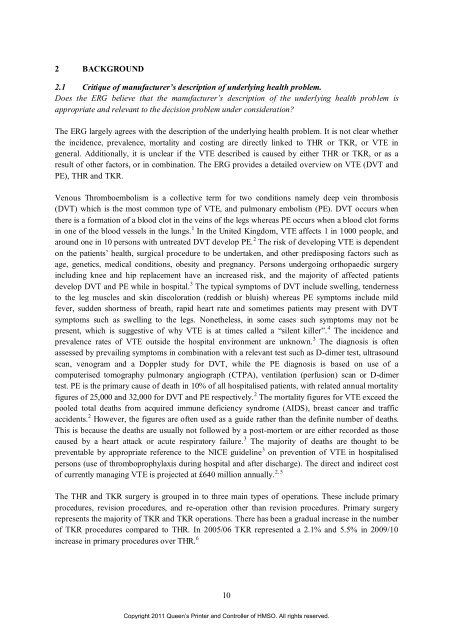Apixaban for the prevention of venous thromboembolism in people ...
Apixaban for the prevention of venous thromboembolism in people ...
Apixaban for the prevention of venous thromboembolism in people ...
Create successful ePaper yourself
Turn your PDF publications into a flip-book with our unique Google optimized e-Paper software.
2 BACKGROUND<br />
2.1 Critique <strong>of</strong> manufacturer’s description <strong>of</strong> underly<strong>in</strong>g health problem.<br />
Does <strong>the</strong> ERG believe that <strong>the</strong> manufacturer’s description <strong>of</strong> <strong>the</strong> underly<strong>in</strong>g health problem is<br />
appropriate and relevant to <strong>the</strong> decision problem under consideration?<br />
The ERG largely agrees with <strong>the</strong> description <strong>of</strong> <strong>the</strong> underly<strong>in</strong>g health problem. It is not clear whe<strong>the</strong>r<br />
<strong>the</strong> <strong>in</strong>cidence, prevalence, mortality and cost<strong>in</strong>g are directly l<strong>in</strong>ked to THR or TKR, or VTE <strong>in</strong><br />
general. Additionally, it is unclear if <strong>the</strong> VTE described is caused by ei<strong>the</strong>r THR or TKR, or as a<br />
result <strong>of</strong> o<strong>the</strong>r factors, or <strong>in</strong> comb<strong>in</strong>ation. The ERG provides a detailed overview on VTE (DVT and<br />
PE), THR and TKR.<br />
Venous Thromboembolism is a collective term <strong>for</strong> two conditions namely deep ve<strong>in</strong> thrombosis<br />
(DVT) which is <strong>the</strong> most common type <strong>of</strong> VTE, and pulmonary embolism (PE). DVT occurs when<br />
<strong>the</strong>re is a <strong>for</strong>mation <strong>of</strong> a blood clot <strong>in</strong> <strong>the</strong> ve<strong>in</strong>s <strong>of</strong> <strong>the</strong> legs whereas PE occurs when a blood clot <strong>for</strong>ms<br />
<strong>in</strong> one <strong>of</strong> <strong>the</strong> blood vessels <strong>in</strong> <strong>the</strong> lungs. 1 In <strong>the</strong> United K<strong>in</strong>gdom, VTE affects 1 <strong>in</strong> 1000 <strong>people</strong>, and<br />
around one <strong>in</strong> 10 persons with untreated DVT develop PE. 2 The risk <strong>of</strong> develop<strong>in</strong>g VTE is dependent<br />
on <strong>the</strong> patients’ health, surgical procedure to be undertaken, and o<strong>the</strong>r predispos<strong>in</strong>g factors such as<br />
age, genetics, medical conditions, obesity and pregnancy. Persons undergo<strong>in</strong>g orthopaedic surgery<br />
<strong>in</strong>clud<strong>in</strong>g knee and hip replacement have an <strong>in</strong>creased risk, and <strong>the</strong> majority <strong>of</strong> affected patients<br />
develop DVT and PE while <strong>in</strong> hospital. 3 The typical symptoms <strong>of</strong> DVT <strong>in</strong>clude swell<strong>in</strong>g, tenderness<br />
to <strong>the</strong> leg muscles and sk<strong>in</strong> discoloration (reddish or bluish) whereas PE symptoms <strong>in</strong>clude mild<br />
fever, sudden shortness <strong>of</strong> breath, rapid heart rate and sometimes patients may present with DVT<br />
symptoms such as swell<strong>in</strong>g to <strong>the</strong> legs. None<strong>the</strong>less, <strong>in</strong> some cases such symptoms may not be<br />
present, which is suggestive <strong>of</strong> why VTE is at times called a “silent killer”. 4 The <strong>in</strong>cidence and<br />
prevalence rates <strong>of</strong> VTE outside <strong>the</strong> hospital environment are unknown. 3 The diagnosis is <strong>of</strong>ten<br />
assessed by prevail<strong>in</strong>g symptoms <strong>in</strong> comb<strong>in</strong>ation with a relevant test such as D-dimer test, ultrasound<br />
scan, venogram and a Doppler study <strong>for</strong> DVT, while <strong>the</strong> PE diagnosis is based on use <strong>of</strong> a<br />
computerised tomography pulmonary angiograph (CTPA), ventilation (perfusion) scan or D-dimer<br />
test. PE is <strong>the</strong> primary cause <strong>of</strong> death <strong>in</strong> 10% <strong>of</strong> all hospitalised patients, with related annual mortality<br />
figures <strong>of</strong> 25,000 and 32,000 <strong>for</strong> DVT and PE respectively. 2 The mortality figures <strong>for</strong> VTE exceed <strong>the</strong><br />
pooled total deaths from acquired immune deficiency syndrome (AIDS), breast cancer and traffic<br />
accidents. 2 However, <strong>the</strong> figures are <strong>of</strong>ten used as a guide ra<strong>the</strong>r than <strong>the</strong> def<strong>in</strong>ite number <strong>of</strong> deaths.<br />
This is because <strong>the</strong> deaths are usually not followed by a post-mortem or are ei<strong>the</strong>r recorded as those<br />
caused by a heart attack or acute respiratory failure. 3 The majority <strong>of</strong> deaths are thought to be<br />
preventable by appropriate reference to <strong>the</strong> NICE guidel<strong>in</strong>e 3 on <strong>prevention</strong> <strong>of</strong> VTE <strong>in</strong> hospitalised<br />
persons (use <strong>of</strong> thromboprophylaxis dur<strong>in</strong>g hospital and after discharge). The direct and <strong>in</strong>direct cost<br />
2, 5<br />
<strong>of</strong> currently manag<strong>in</strong>g VTE is projected at £640 million annually.<br />
The THR and TKR surgery is grouped <strong>in</strong> to three ma<strong>in</strong> types <strong>of</strong> operations. These <strong>in</strong>clude primary<br />
procedures, revision procedures, and re-operation o<strong>the</strong>r than revision procedures. Primary surgery<br />
represents <strong>the</strong> majority <strong>of</strong> TKR and TKR operations. There has been a gradual <strong>in</strong>crease <strong>in</strong> <strong>the</strong> number<br />
<strong>of</strong> TKR procedures compared to THR. In 2005/06 TKR represented a 2.1% and 5.5% <strong>in</strong> 2009/10<br />
<strong>in</strong>crease <strong>in</strong> primary procedures over THR. 6<br />
10<br />
Copyright 2011 Queen’s Pr<strong>in</strong>ter and Controller <strong>of</strong> HMSO. All rights reserved.
















